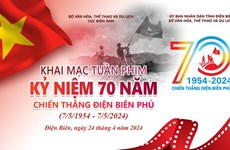Female artisan preserves M’nong culture
 Kau Thi Mai was translating epics of the M'nong people (Photo: baodaklak.vn)
Kau Thi Mai was translating epics of the M'nong people (Photo: baodaklak.vn)Dak Nong (VNA) – A female artisan of the M’nong people in the Central Highlands province of Dak Nong has devoted herself to keep alive traditional music and literature for younger generations.
Kau Thi Mai, a villager living in the Bu Prang village of the Dak N’Drung-Dak Song district, has spent nearly 20 years learning and researching the songs and epics of the M’nong people.
She began her love for the art from her father, the late artisan and patriarch Dieu Kau, when she was a child. She travelled with her father around the region to collect and record songs and epics performed by elderly villagers.
“My father infused his love of the M’nong culture into many of his students, including myself. He delivered his work on researching and preserving the epics to me,” said the 42-year-old woman.
Not only does she pour her soul into teaching the legends to her fellow villagers, she also helps provincial cultural authorities record tapes and write books and other documents on the cultural legacy.
Mai is working hard on a new project to investigate and write a collection of documents on M’nong epics that will be used at primary and secondary schools in the Central Highlands.
The epics of the M’nong people, called Ot N’drong, are oral literary works handed down from one generation to the next. They are verses and songs which contain thousands of words but are easy to learn by heart.
She said that Ot N’drong featured the myths, legends and stories of local people, who were brave and compassionate.
The epics contained stories about the lives of the M’nong people, describing upheavals within their society, natural calamities and social relationships told in a boasting, heroic and impressive style.
"My villagers sing the epics every day after hard work in the fields. Singing helps us to become stronger and happier in our lives and work."
"M’nong people, particularly children and youth, should learn and perform Ot N’drong because ethnic minority people can’t survive without their traditional culture," she said.
Since 1988, the Hanoi-based Institute of Cultural Studies has worked with Dak Lak Province’s Department of Culture, Sports and Tourism on a long-term project to research and collect Central Highlands epics.
Thanks to the project, Central Highlands songs and epics have published and recorded more than 2,000 books and several thousand tapes and videos in different languages.
The Dak Nong Province Museum has 150 books featuring 86 Ot N’drong epics in both M’nong and Vietnamese language.
Nguyen Van Toan, Director of the Dak Nong Province’s Department of Education and Training, said that Ot N’drong played a role in the country’s folk literature.
It was recognised as the national intangible cultural heritage property in late 2014.
“We have worked with local artisans and elderly villagers to teach the epics in schools,” he said.
Toan believes that the most effective method for preserving epics is not to collect and transcribe them, but rather to expand teaching at schools.
In addition, the oral tradition by reciting the works should also be encouraged more frequently during local activities and festivals.
"I think the best way to keep epic works alive among young people is to get them to learn their epics in their hearts and souls," said Toan, in an interview with the Liberated Saigon newspaper.
"For young villagers, learning epics helps them to see and understand the fields, mountains, trees, birds and streams running through the woods in their homeland," he said.
"Teaching the epic tradition to younger villagers is crucial," he said. "But the number of ethnic artisans like Mai, who are able to introduce and translate the epics from ethnic languages into Vietnamese, is too small."
"The epic tradition and artisans are some of our province’s most precious property," he said.-VNA













